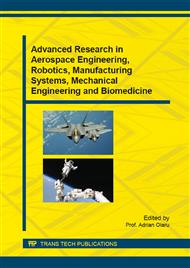p.63
p.75
p.80
p.85
p.92
p.99
p.104
p.110
p.117
Finite Element Analysis for Deep Drawing Process and Part Shape Optimization
Abstract:
The paper presents some aspects regarding the sheet metal deep drawing process and shape optimzation for such parts using Finite Element Analysis. Simulation based design approaches have been used for forming processes. Using similar approach, a full process simulation and optimisation was undertaken in the present work. The work done here involved computer simulations of the forming processes to evaluate the amount of strain and stress each forming process contributed to the final product. Based on the simulation results, recommendation to change the product shape were presented. Not all the virtual products should be manufactured and the Finite Element Analysis eliminate all the possible errors and let the designers to optimize the geometry before designing the Molds and Dies for Deep Drawing process.
Info:
Periodical:
Pages:
92-96
Citation:
Online since:
November 2015
Authors:
Price:
Сopyright:
© 2015 Trans Tech Publications Ltd. All Rights Reserved
Share:
Citation:


